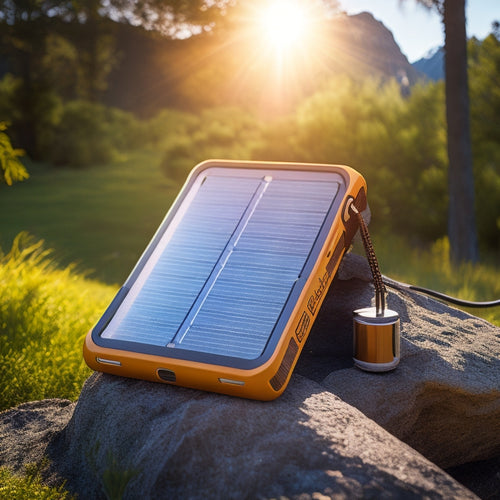
Maximize Your Home Battery System Efficiency
Share
You can maximize your home battery system efficiency by adopting a proactive approach that encompasses monitoring, maintenance, and enhancement strategies to guarantee peak performance, prolong component lifespan, and reduce energy costs. Monitor your battery's state through real-time visibility and regular water level checks to prevent potential issues. Inspect physical components regularly to prevent efficiency loss, and update your system's software to introduce new features and improve performance. By refining charge and discharge, managing energy usage patterns, and performing regular deep cycles, you'll be well on your way to achieving peak efficiency - and there's more to investigate to release your system's full potential.
Overview
- Monitor your home battery system's state of health and performance metrics to optimize its efficiency and prevent potential issues.
- Regularly inspect and maintain physical components, such as connections and cables, to prevent efficiency loss and prolong lifespan.
- Update system software regularly to introduce new features, improve performance, and enhance battery health.
- Optimize charge and discharge patterns by adjusting timing, shifting non-essential loads, and prioritizing essential loads to reduce grid reliance.
- Perform regular deep cycles and maintain an ideal cycling range of 20% to 80% capacity to enhance battery longevity and prevent performance degradation.
Monitor Your Battery's State
Efficiency begins with awareness, and monitoring your battery's state is crucial to optimizing its performance. You need to keep tabs on your battery's health to guarantee it's functioning at its best.
Employ monitoring tools to track charging patterns, state indicators, and performance metrics. This data provides significant observations into your usage analytics, helping you identify areas for improvement.
Regularly checking water levels water level checks and scheduling equalization charges can also help prevent battery stratification and sulfation. By regularly checking your battery's state, you'll be able to detect potential issues before they become major problems.
Stay on top of your battery's condition to maximize its lifespan and overall efficiency. With real-time visibility, you'll have the freedom to make informed decisions about your energy usage and optimize your home battery system for peak performance.
Optimize Charge and Discharge
Now that you're monitoring your battery's state, it's time to fine-tune its charging and discharging habits. By optimizing charge timing, you can guarantee your battery is fully charged when you need it most.
Consider shifting non-essential loads to off-peak hours or when renewable energy sources are abundant, factoring in seasonal variations in energy demand. This approach allows you to store excess energy and reduce your reliance on the grid.
When it comes to discharge strategy, adopt a smart approach that prioritizes essential loads, such as refrigeration and lighting, over non-essential ones, like entertainment systems.
Balance Your Battery Banks
As you've optimized your charging and discharging habits, it's essential to confirm your battery banks are balanced to maximize their performance and lifespan. Unbalanced banks can lead to reduced capacity, increased wear, and even safety issues. To guarantee balance, consider the following factors:
| Battery Chemistry | Bank Configuration | Balancing Requirements |
|---|---|---|
| Lead-Acid | Series-Parallel | Regularly check and adjust voltage and charge rates |
| Lithium-Ion | Parallel-Series | Monitor and adjust cell voltage and temperature |
| Nickel-Cadmium | Series-Series | Perform regular capacity tests and rebalancing |
Update Your System's Software
Your home battery system's software is the brain behind its operation, controlling charging and discharging patterns, monitoring performance, and ensuring safe operation.
To maximize efficiency, it's vital to keep this software up-to-date. Regular updates can reveal new features, improve system performance, and fix bugs that might be hindering your system's potential.
By updating your system's software, you can enjoy benefits like optimized charging and discharging, improved battery health, and enhanced system monitoring.
Additionally, maintaining a healthy battery state of charge (SOC) and depth of discharge (DOD) prevents overcharging and undercharging battery monitoring and maintenance, which is essential for prolonged battery lifespan.
By setting a discharge limit and performing routine inspections, you can extend the lifespan of your solar battery and maintain its health.
Inspect Physical Components Regularly
You'll want to regularly inspect your home battery system's physical components to guarantee peak performance.
Start by checking the battery connections for signs of wear or corrosion, as loose or corroded connections can greatly reduce efficiency.
Additionally, keep the system clean and free of dust and debris, as a clean environment will help prevent overheating and prolong the lifespan of your components.
Battery Connection Check
Reliability hinges on the integrity of battery connections, which can be compromised by corrosion, loose terminals, or damaged cables.
As you inspect your home battery system, pay close attention to the connections between batteries, inverters, and other components. Check for signs of wear, corrosion, or damage on terminals, cables, and connectors. Confirm that all connections are secure and tightened to the recommended torque specification.
Different battery types, such as lithium-ion or lead-acid, may require specific connection methods. Verify that your connection methods are compatible with your battery type.
Cleanliness Is Key
Dust and dirt accumulation on physical components can considerably impede the efficiency of your home battery system. Regularly inspecting and cleaning these components is vital for peak performance.
You'll reap significant cleanliness benefits, including improved energy storage and reduced wear on your system. During battery maintenance, check for signs of corrosion, rust, or moisture buildup on terminals, connectors, and cables.
Gently wipe away dirt and grime with a soft-bristled brush or cloth. Guarantee proper airflow around the system to prevent overheating.
Manage Your Energy Usage Patterns
By optimizing your daily energy usage patterns, you can maximize the efficiency of your home battery system. Your energy consumption habits directly impact the performance of your system. Understanding your usage habits, peak times, and off-peak savings opportunities can help you make informed decisions about load management.
| Time of Day | Energy Consumption | Adjustment Opportunity |
|---|---|---|
| Morning | High (cooking, lighting) | Delay non-essential loads, use natural light |
| Afternoon | Medium (computing, entertainment) | Optimize appliance efficiency, use power strips |
| Evening | High (cooking, lighting) | Shift to off-peak hours, use smart technology |
| Night | Low (sleep mode) | Schedule deep charging, automate home automation |
| Seasonal | Varies (heating, cooling) | Make seasonal adjustments, optimize load management |
Perform Regular Deep Cycles
You'll want to perform deep cycles on your home battery system regularly to maintain its efficiency and extend its lifespan.
The frequency at which you cycle your batteries matters, as it affects their overall health and ability to hold a charge.
Additionally, the depth of each cycle also impacts performance, so it's crucial to find the right balance to get the most out of your system.
Cycle Frequency Matters
How frequently do you cycle your home battery system? This question is essential because cycle frequency matters when it comes to maximizing your energy storage's efficiency.
If you don't cycle your batteries regularly, they may not be functioning at their peak level, reducing their overall cycle longevity. In fact, infrequent cycling can lead to reduced capacity, decreased performance, and even premature degradation.
By performing regular deep cycles, you guarantee your batteries are consistently charged and discharged, maintaining their health and extending their lifespan. This, in turn, allows you to store more energy and enjoy greater freedom from the grid.
Depth Impacts Performance
Optimizing your home battery system's performance hinges on performing regular deep cycles, as the depth of discharge considerably impacts its overall efficiency.
You'll want to measure the depth of discharge accurately to guarantee peak performance. This depth measurement is essential, as it directly affects the battery's lifespan and overall capacity.
To achieve depth optimization, you should aim to cycle your batteries between 20% and 80% capacity regularly. This allows the battery to exercise its full potential without causing undue stress.
Frequently Asked Questions
Can I Install a Home Battery System Myself?
You can attempt a DIY installation, but be aware that battery system regulations vary by region, and improper setup can void warranties or even pose safety risks, so it's essential to research and comply with local codes and manufacturer guidelines.
How Often Should I Inspect My Battery Terminals?
Like a detective searching for clues, you'll want to regularly scrutinize your battery terminals, ensuring terminal corrosion doesn't quietly sabotage your system; aim to inspect every 3-6 months, or as manufacturer guidelines dictate, to keep your batteries running smoothly and efficiently.
Are Lithium-Ion Batteries Safe for Home Use?
You're wise to wonder if lithium-ion batteries are safe for home use; they are, as long as you follow proper installation and maintenance guidelines, ensuring a long battery lifespan and minimizing lithium ion safety risks.
Can I Upgrade My Existing Battery System?
As you commence a quest for energy independence, you're wondering if you can upgrade your existing battery system. Yes, you can, but beware of battery compatibility issues; investigate upgrading options carefully to guarantee seamless integration and ideal performance.
Do Home Battery Systems Work During Power Outages?
During a power outage, you'll be glad to know that your home battery system kicks in, providing a reliable battery backup to keep your essentials running, ensuring your freedom from grid dependence and keeping you powered up when it matters most.
Ready to Buy
By following these essential steps, you'll access the full potential of your home battery system, converting it into a powerhouse of efficiency! You'll squeeze every last drop of energy from your batteries, maximizing your savings and minimizing your carbon footprint. Your system will hum along like a finely-tuned machine, giving you unparalleled control over your energy usage. Get ready to bask in the glory of a perfectly optimized home battery system that's the envy of the neighborhood!
Related Posts
-

Fastest Solar Chargers for Emergency Power
When choosing the fastest solar chargers for emergency power, you need to focus on features like rapid charging capab...
-

The Future of Residential Energy Storage
The future of residential energy storage looks promising and cost-effective for you. With lithium-ion battery prices ...
-

Cost of Home Solar Battery
You're looking to invest in a home solar battery to reduce your grid reliance, but you're curious about the cost. The...


